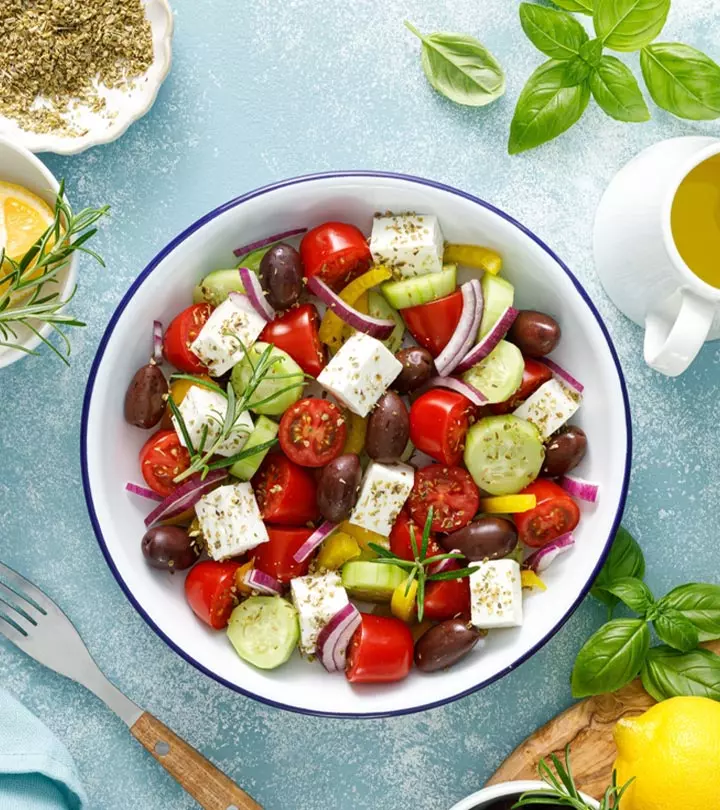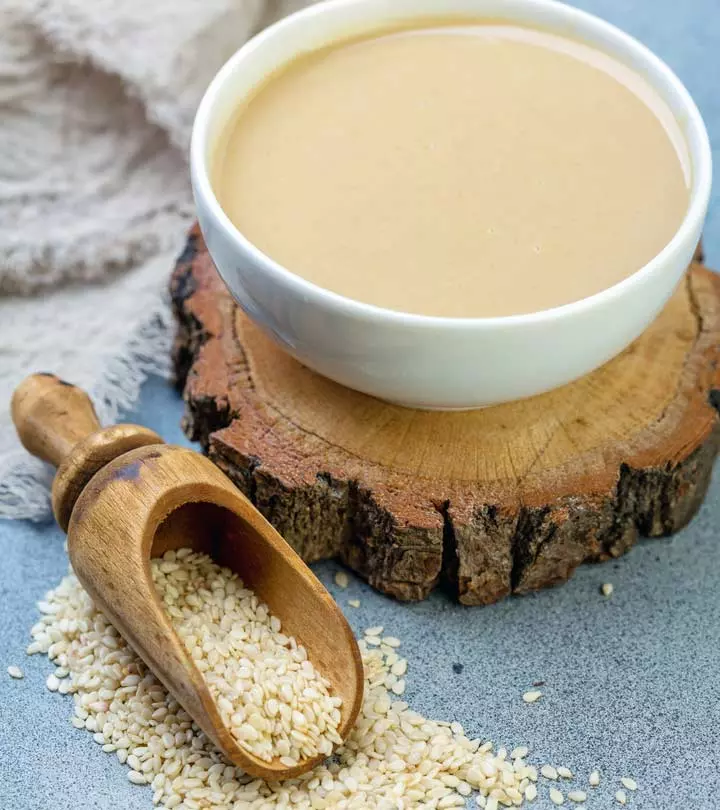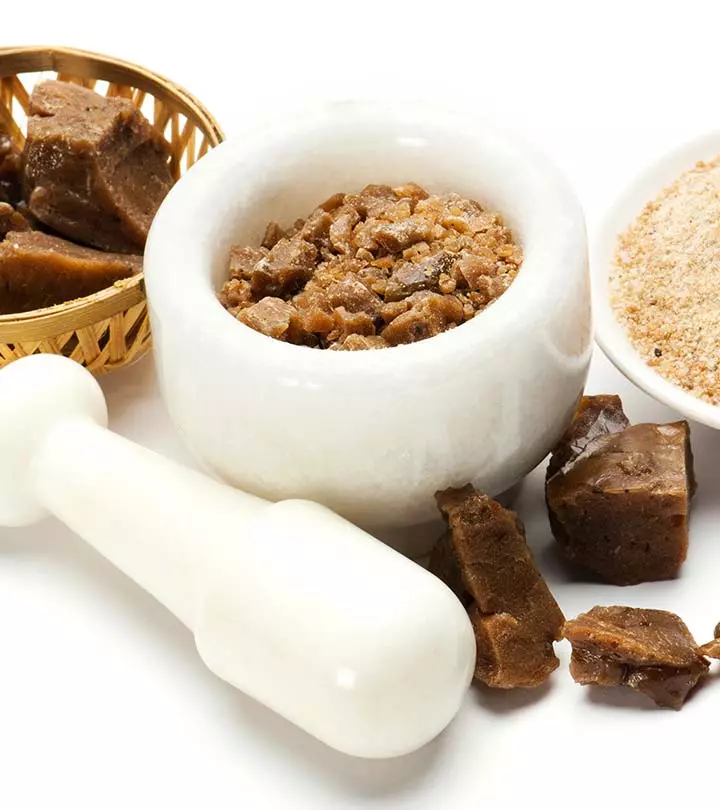4 Amazing Feta Cheese Nutrition Facts You Need To Know!
Get stronger bones, lose weight, and boost your gut health with just a bit of cheese!

Image: Shutterstock
Feta cheese is a creamy cheese variant and is mostly used in Mediterranean and Greek delicacies. The benefits of feta cheese can be attributed to its high amount of vitamins and minerals.
Feta cheese is a perfect treat to satisfy your taste buds. It enhances the taste of your meal and contains high amounts of calcium, which is crucial for maintaining healthy bones. But is feta cheese healthy? Can it cause any health issues?
Scroll down to know more about the feta cheese nutrition facts, benefits, and healthy recipes.
 Know Your Ingredient: Feta Cheese
Know Your Ingredient: Feta CheeseWhat Is It?
A Greek brined cheese made from sheep’s milk or a combination of sheep and goat milk that has a pungent taste.
What Are Its Benefits?
It improves bone health, aids in weight loss, promotes gut health, and keeps the nervous system healthy.
Who Can Use It?
Anyone can consume it except people with milk allergy and lactose intolerance and those on antibiotics and depression medication.
How Often?
You can consume 2 to 3 servings daily.
Caution
Avoid consuming feta cheese if you are pregnant. Excess consumption may spike blood pressure and increase the risk of bacterial infection and miscarriage.
In This Article
What Is Feta Cheese?
Mediterranean diet expert Elena Paravantes, RDN, explains, “Feta is a Greek brined cheese (as it is aged in a brine solution) made from sheep’s milk or a combination of sheep and goat milk. It is aged in the brine for at least two months. However, good quality feta is aged for 12 months. It has a tangy, rich, and slightly salty flavor.”
Feta cheese is a protected designation of origin (PDO) food (1). It is recognized by the European Union as a traditional Greek product. Feta cheese is rindless. The fresh cheese has a clean, acidic, and salty flavor, while matured cheese has a sharp, pungent flavor. It appears white because feta cheese is made from sheep, goat, or buffalo milk. It is also produced from cows’ milk. However, manufacturers decolorize the fat to get the required white color (2).
According to a survey on the feta cheese consumption of 1232 healthy Greek adults published in Foods Journal, the consumption per capita per day ranged between 5 g and 336 g with an average value of 50.3 g and a median value of 39 g. Check out the graph to learn more.

Greek Adults' Feta Cheese Consumption (G) Per Capita And Per Day
Source: Nutritional Characteristics of Prepacked Feta PDO Cheese Products in Greece: Assessment of Dietary Intakes and Nutritional ProfilesKayla Girgen, RD, LD, adds, “It’s a staple ingredient that I keep in my fridge at all times. What I love most about feta cheese is that a little bit goes a long way. Feta is excellent for cooking because of its natural saltiness.”
 Trivia
TriviaThere is a link between every traditional cheese and its place of origin. Feta cheese, too, has an interesting history. Let’s trace back its roots in the next section.
Key Takeaways
- The nutrient-rich feta cheese is made from a mix of goat and sheep milk.
- It is a rich source of calcium, and it improves bone health, promotes weight loss, and boosts gut health.
- Moderate consumption of this cheese is advised for people with high blood pressure as it is matured in salt brine.
Origin Of Feta cheese
The origin of feta (meaning “slice”) cheese can be traced back to ancient Greece. Feta cheese finds a mention in the works of Aristotle, Pythagoras, and Homer’s Odyssey. The Greeks called it ’feta’ because they sliced the cheese before putting it into the barrel – a practice that Greeks still follow.
Traditionally, feta cheese is produced from sheep and goat milk. It is because most East-Mediterranean nations have:
- Modest and irregular rainfall
- Hot and dry summers
- Mountainous landscapes
This type of environment is not suited to meet the fodder requirements of dairy cattle, except sheep and goats. Hence, they prepared cheese from the milk of these two animals. The cheese was preserved and ripened under brine until consumption, as there was no way to refrigerate it, and transporting milk was difficult (3).
But, is feta cheese good for you? Let us find that out. Feta is a low-fat cheese and a good source of important nutrients. Scroll down to know more about its nutritional value.
Nutritional Profile Of Feta Cheese
A wedge of feta cheese (about 1 oz) contains (4):
Calories | 101 kcal |
Proteins | 5.4 g |
Carbohydrates | 1.47 g |
Total lipids (Fat) | 8.17 g |
Calcium | 187 mg |
Sodium | 433 mg |
Potassium | 23.6 mg |
Phosphorus | 128 mg |
Magnesium | 7.2 mg |
Cholesterol | 33.8 mg |
, MS, RD, LDN, CNSC, says, “As cheeses go, feta is a fairly healthy option. It is packed with nutrients like calcium, sodium, phosphorus, and B vitamins. Feta is also low in saturated fat and calories than many other kinds of cheese.” The feta cheese nutrition facts show that it can be a healthy addition to your diet.
While there are many varieties to choose from, each offering their own cheese benefits, feta stands apart from the rest. Learn more about the many health benefits feta has to offer in the next section
Health Benefits Of Feta Cheese

1. May Improve Bone Health
Feta cheese is a great source of calcium, a mineral that maintains the bones.
Researchers found that consuming cheese and milk improved bone mineral density in rats. They concluded that consuming cheese could be beneficial in preventing osteoporosis and the risk of age-related bone loss (5),(6).
2. May Promote Weight Loss

Feta cheese has a low fat content than other types of cheese. The calcium and fatty acid complexes in cheese may bind in the gut and prevent fat absorption. It also boosts fat breakdown and reduces fat storage in the cells.
The high protein content of feta cheese increases satiety, making it a good option for calorie-restricted diets. Also, dairy products (including feta cheese, which is made from goat milk) contain polyunsaturated fatty acids called conjugated linoleic acids (CLAs). Animal and human studies have shown that CLA reduces body weight and fat (7), (8).
3. May Promote Gut Health
Lactobacillus co-starter culture, a probiotic, is used for manufacturing feta cheese. These gut-friendly bacteria support digestive functions, such as food breakdown, nutrient absorption, and fighting harmful bacteria to keep your gut healthy (9).
Moreover, feta cheese made of goat milk contains short-chain fatty acids and is easy to digest (10). It is good for those who are allergic to cow milk. Felicia Newell, RD, says, “Feta tends to be less allergenic and is hence good for people who are slightly allergic to dairy.”
4. Good Source Of Vitamins
Feta cheese contains vitamins B6 (5% daily value), and cobalamin (vitamin B12) (8% daily value). It also contains vitamin D that helps the body absorb calcium and strengthens the bones. Vitamin B6 facilitates metabolism, and cobalamin keeps the nervous system healthy (4), (11), (12), (13).
Feta cheese can be an excellent addition to your diet. But is it suitable for someone on a low-carb diet? Find out in the next section.
Is Feta Cheese Good For A Low-Carb Diet?
Feta cheese contains only 1-2 grams of carbohydrates per serving, making it perfect for those wanting to reduce their carb intake. Additionally, it is a good source of protein and essential healthy fats that can keep you satiated for a long time (4), (14).
You can add this versatile and tasty ingredient to your salads, omelets, and other low-carb dishes. Remember, portion control is key to managing your calorie intake while reaping the benefits of this delicious cheese.
There is no reason you should not include feta cheese in your diet. You can also easily make it at home. All you need is – a mixture of milk, starter culture, and patience! Here is the process.
How To Make Feta Cheese
What You Need
- 1 gallon of whole milk
- ¼ teaspoon of feta cheese culture
- ½ cup of water
- ½ teaspoon of calcium chloride
- ½ teaspoon of liquid rennet
For Brine
- 8 cups of water
- 5 tablespoons of salt
- 1 teaspoon of calcium chloride
- ¼ teaspoon of white vinegar
Method
- Mix one-fourth cup of water and half a teaspoon of calcium chloride in a bowl.
- In another bowl, mix one-fourth cup of water and liquid rennet.
- Heat milk in a double boiler over medium heat until it reaches 86℉.
- Add cheese culture to it and let it dissolve for a few minutes. Stir the mixture. Cover and let it boil for an hour on 86℉.
- Mix calcium chloride with milk and stir for a minute. Add the rennet mixture to it and stir again.
- Allow the milk to curdle at room temperature for an hour.
- Check the curd’s firmness with the back of a spoon.
- Slice the curd into 1-inch squares. Stir gently with a rubber spatula and rest it for 5 to 10 minutes.
- Maintain 86°F at all times and stir the curd until it sinks to the bottom of the pot.
- Turn off the heat. Scoop out the liquid (whey).
- Place the multi-layered cheesecloth in a colander. Drain the remaining whey from the curd.
- Wrap the cheesecloth around the curd and hang it for 4 hours to drain the whey.
- Mix the brine ingredients in a large container. Let the cheese soak in it for at least 8 hours and up to 3 weeks.
Additional Tips
- Do not boil the milk as it decreases its calcium content.
- Add calcium chloride to make the cheese firm.
- Do not use UHT or ultrapasteurized milk for making feta cheese.
- Use liquid rennet or half of the rennet tablet diluted in one-fourth cup of cool water. You may also use mesophilic starter culture or a tablespoon of yogurt instead of a feta starter culture.
 Quick Tip
Quick TipFeta cheese is used in several vegetarian and non-vegetarian dishes like salads and pasta. Here are a few popular recipes you may try at home.
Popular Feta Cheese Recipes

1. Tomato, Basil, And Feta salad (serves 2)
What You Need
- 3 tomatoes, diced
- 1 small cucumber, peeled and chopped
- 2 green onions, chopped
- ¼ cup of fresh basil leaves, cut into thin strips
- 3 tablespoons of olive oil
- 2 tablespoons of balsamic vinegar
- 3 tablespoons of crumbled feta cheese
- 1 teaspoon of black pepper, freshly ground
- Salt, as needed
Method
- Toss all ingredients in a large bowl.
- Sprinkle salt and pepper and enjoy!
2. Spinach And Feta Pasta (serves 3)
What You Need
- 8 ounces of penne pasta
- 8 ounces of feta cheese, crumbled
- 2 tablespoons of olive oil
- ½ cup of onion, chopped
- 1 garlic clove, minced
- 3 cups of tomatoes, chopped
- 1 cup of mushrooms, sliced
- 2 cups of spinach leaves
- A pinch of red pepper flakes
- Salt, as needed
- Black pepper, as needed
Method
- Cook pasta and drain it.
- Fry onion and garlic over medium heat until golden brown.
- Add tomatoes, mushrooms, and spinach for 2-5 minutes.
- Add salt, pepper, and red pepper flakes as desired.
- Reduce the heat. Stir in pasta and feta cheese until it is done.
Note:
This pasta could be heavy on digestion. If you have a sensitive digestive system, you may want to avoid this recipe.
3. Hot And Spicy Sun Dried Tomato, Spinach, and Feta Cheese Salad (serves 2)

What You Need
- 1 tablespoon of virgin olive oil
- 1 red chili
- 300 grams of spinach leaves
- 6 sun dried tomatoes
- ½ a lime
- 20 grams of feta cheese
- 2 tablespoons of flaked almonds, toasted
- Salt, to taste
Method
- In a large skillet, heat the olive oil.
- Add the spinach and sauté until the leaves reduce in volume.
- Cut the chili in thin slices. Add them along with the dried tomatoes.
- Mix and season with the salt and lime juice.
- Serve hot with diced feta cheese and the flaked almonds
4. Feta Cheese Stuffed Peppers (serves 4)
What You Need
- 1 cup of crumbled feta cheese
- 4 bell peppers
- 1 cup of quinoa, cooked
- 1/2 cup of cherry tomatoes, halved
- 1/4 cup of olives, sliced
- Olive oil, salt, and pepper to taste
Method
- Warm the oven to 190°C (375°F).
- Slice off the peppers’ tops and take out the seeds.
- Combine the quinoa, olives, olive oil, tomatoes, feta, salt, and pepper in a bowl.
- Stuff the peppers with the mixture and then put them in a baking dish.
- Bake the peppers for 25 to 30 minutes or until they are soft.
Holly Klamer, a Michigan-based RDN, explains, “Like other cheeses, feta can be good for you as long as it is eaten in moderation. The American Heart Association recommends 2-3 servings of low-fat dairy per day to healthy adults.” Moreover, feta cheese has a high salt content. Therefore, keep these precautions in mind before consuming it.
Risk Factors Associated With Feta Cheese

Feta cheese is matured in a salt brine to (15):
- Control bacterial growth and activity
- Control different enzymatic activities in cheese
- Promote whey outflow and reduce cheese moisture
- Influence the cheese proteins and texture
But such a high salt content might be risky and cause:
1. High Blood Pressure
Salt increases arterial blood pressure. While the process is unknown, it is believed to be connected to the kidneys’ difficulty in eliminating excess salt (16).
2. Pregnancy Issues
Traditionally, feta cheese is prepared from raw milk to shorten the ripening process and maintain its pungent taste. Listeria monocytogenes is a pathogen found in about 4% of US raw milk. It causes listeriosis, a type of infection that may lead to miscarriage. Hence, avoid raw milk-based cheese if you are pregnant (17), (18).
Infographic: 4 Major Benefits Of Feta Cheese
Feta is an extremely nutritious cheese variant whose addition to your salad amps up its taste and texture. It is rich in nutrients and extremely good for your health. In the infographic below, we have listed the major ways this cheese can benefit you. Take a look.

Illustration: StyleCraze Design Team
To Conclude
Feta cheese is soft, delicious, and creamy and is used in various dishes. It is replete with minerals, vitamins, fats, and other nutrients that promote overall health. The benefits of feta cheese include stronger bones and healthy weight gain. In addition, it is loaded with vitamin B complex that may promote nervous system health. You can add feta cheese to your salads, pasta, pizzas, and other dishes. However, excess consumption may spike blood pressure due to its high sodium content. Limit its use and consult a doctor if you experience any adverse reactions.
Frequently Asked Questions
Is feta cheese anti-inflammatory?
Yes. Feta cheese is a type of goat cheese that is replete with beneficial polyunsaturated fatty acids and conjugated linolenic acid. These nutrients help lower inflammatory biomarkers thanks to their anti-inflammatory properties (19).
Can I eat feta cheese raw?
Yes. You can add raw feta cheese to your salads, sandwiches, and other savory dishes.
Is feta cheese good for fatty liver?
No. Feta cheese, like most cheeses, is high in saturated fatty acids. Saturated fatty acids lead to fat accumulation in the liver and may increase oxidative stress (20).
Can individuals with diabetes eat feta cheese?
Yes, though in moderate amounts. Feta cheese is rich in saturated fatty acids and notable guidelines have recommended limiting its intake to less than10% of one’s total calorie intake (21).
Does feta cheese cause gas?
Possibly, if you are lactose intolerant. Cheese is a rich source of lactose which, if consumed by those who are lactose intolerant, may lead to gas, bloating, cramps, and other gastrointestinal troubles.
Illustration: Amazing Feta Cheese Nutrition Facts You Need To Know!

Image: Stable Diffusion/StyleCraze Design Team
Learn about the amazing health benefits and nutrient facts of feta cheese. Watch this video to discover why it’s a great addition to your diet.
References
Articles on StyleCraze are backed by verified information from peer-reviewed and academic research papers, reputed organizations, research institutions, and medical associations to ensure accuracy and relevance. Read our editorial policy to learn more.
- Nutritional Characteristics of Prepacked Feta PDO Cheese Products in Greece: Assessment of Dietary Intakes and Nutritional Profiles
https://www.ncbi.nlm.nih.gov/pmc/articles/PMC7143250/ - Cheese Varieties Ripened in Brine
https://www.sciencedirect.com/science/article/pii/B9781845690601500260 - Characteristics of major traditional regional cheese varieties of East-Mediterranean countries: a review
https://link.springer.com/article/10.1051/dst:2008023 - FoodData Central
https://fdc.nal.usda.gov/fdc-app.html#/food-details/173420/nutrients - Milk Calcium Taken with Cheese Increases Bone Mineral Density and Bone Strength in Growing Rats
https://www.jstage.jst.go.jp/article/bbb/66/11/66_11_2342/_article/-char/ja/ - Cheese in nutrition and health
https://link.springer.com/article/10.1051/dst:2008012 - Healthy bones – Activity and nutrition
https://academic.oup.com/pch/article/7/5/315/2658400?login=true - Conjugated Linoleic Acid Effects on Cancer Obesity and Atherosclerosis: A Review of Pre-Clinical and Human Trials with Current Perspectives
https://www.mdpi.com/2072-6643/11/2/370 - Greek functional Feta cheese: enhancing quality and safety using a Lactobacillus 3 plantarum strain with probiotic potential
https://www.sciencedirect.com/science/article/abs/pii/S0740002017309036 - The Comparison of Fatty Acid Composition and Lipid Quality Indices in Hard Cow Sheep and Goat Cheeses
https://www.mdpi.com/2304-8158/9/11/1667 - Vitamin D: importance in the prevention of cancers type 1 diabetes heart disease and osteoporosis
https://academic.oup.com/ajcn/article/79/3/362/4690120?login=true - Folate and Vitamin B6 From Diet and Supplements in Relation to Risk of Coronary Heart Disease Among Women
https://jamanetwork.com/journals/jama/article-abstract/187209 - B Vitamins in the nervous system: Current knowledge of the biochemical modes of action and synergies of thiamine pyridoxine and cobalamin
https://onlinelibrary.wiley.com/doi/full/10.1111/cns.13207 - Protein, weight management, and satiety
hhttps://www.sciencedirect.com/science/article/pii/S0002916523236643 - Effect of Salt and Chymosin on the Physico-Chemical Properties of Feta Cheese During Ripening
https://www.sciencedirect.com/science/article/pii/S0022030299753270 - Links Between Dietary Salt Intake Renal Salt Handling Blood Pressure and Cardiovascular Diseases
https://journals.physiology.org/doi/full/10.1152/physrev.00056.2003?view=long&pmid=15788708 - Enhancement of low-fat Feta cheese characteristics using probiotic bacteria
https://onlinelibrary.wiley.com/doi/full/10.1002/fsn3.1889#fsn31889-bib-0018 - Listeria monocytogenes – Threat to a Safe Food Supply: A Review
https://www.sciencedirect.com/science/article/pii/S0022030290787486 - Consumption of Goat Cheese Naturally Rich in Omega-3 and Conjugated Linoleic Acid Improves the Cardiovascular and Inflammatory Biomarkers of Overweight and Obese Subjects: A Randomized Controlled Trial
https://www.ncbi.nlm.nih.gov/pmc/articles/PMC7285099/ - Isocaloric Dietary Changes and Non-Alcoholic Fatty Liver Disease in High Cardiometabolic Risk Individuals
https://www.ncbi.nlm.nih.gov/pmc/articles/PMC5691682/ - Nutritional Recommendations for Individuals with Diabetes
https://www.ncbi.nlm.nih.gov/books/NBK279012/
Read full bio of Avantii Deshpaande
Read full bio of Payal Karnik
Read full bio of Ravi Teja Tadimalla
Read full bio of Himanshi Mahajan



























Community Experiences
Join the conversation and become a part of our empowering community! Share your stories, experiences, and insights to connect with other beauty, lifestyle, and health enthusiasts.